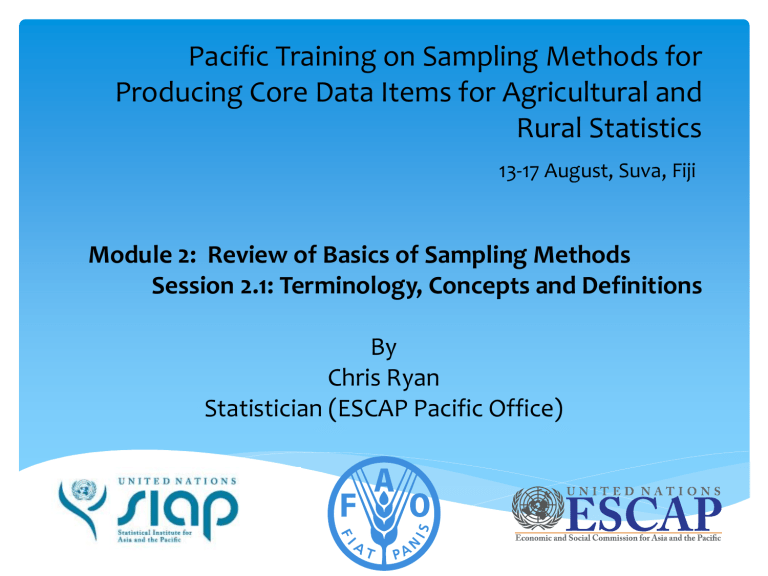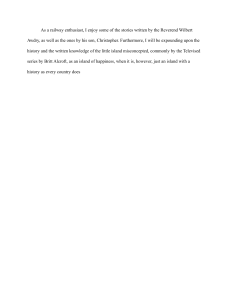
Pacific Training on Sampling Methods for Producing Core Data Items for Agricultural and Rural Statistics 13-17 August, Suva, Fiji Module 2: Review of Basics of Sampling Methods Session 2.1: Terminology, Concepts and Definitions By Chris Ryan Statistician (ESCAP Pacific Office) Topics Covered What is PPS Sampling? What is 2-stage Sampling Incorporating PPS sampling in to 2-stage sampling Estimation formula for 2-stage sampling with PPS Probability Proportional to Size Sampling (PPS) This sampling technique is a little more complex than others used in the Pacific The size of the unit is used to determine its chance of selection Examples of the size of a unit include: The number of households in a village The number of students in a school Example of PPS sampling Step 1: Determine number of islands to select (below = 3) Step 2: Compute the skip = 2,100 / 3 = 700 Step 3: Select a random start between 0 and 700 =rand()*700 (below = 467) Step 4: Select the 3 islands by adding the skip to the random start Island Island Island Island Island Island Island Island Island Island 1 2 3 4 5 6 7 8 9 10 # dwellings Cum # dwell Sel'n number 458 458 347 805 467 294 1099 255 1354 1167 232 1586 167 1753 144 1897 1867 102 1999 59 2058 42 2100 Example of PPS sampling 2 EA 100101 100102 100103 100104 100105 100106 100201 100202 100203 100204 100205 100206 100207 # HHs 43 81 52 61 44 38 72 49 47 33 61 63 51 Cum # HHs Selection 43 15 124 176 237 281 243 319 391 440 487 471 520 581 644 695 EA 100301 100302 100303 100304 100305 100306 100307 100308 100309 100310 100311 100312 100313 # HHs 48 38 71 55 51 41 49 73 48 39 32 67 58 Cum # HHs Selection 743 699 781 852 907 958 927 999 1048 1121 1169 1155 1208 1240 1307 1365 Number of HHs 1365 Number of EAs 26 Number of EAs to select 6 Skip 227.5 Random Start 14.04546 Seln 1 15 Seln 2 243 Seln 3 471 Seln 4 699 Seln 5 927 Seln 6 1155 Probability Proportional to Size Sampling (PPS) The ordering of the units in the population before selection can be important If the ordering is done by geographical position then better geographical representativeness can be achieved If the ordering is done by the size of the unit, then better representativeness can be achieved from a size perspective Multi-stage sampling As the name suggests, this sampling approach involves more than one stage (most commonly two) At each stage, a different level of unit is selected, egs: a) 1st stage : Villages b) 1st stage : Schools 2nd stage : Households 2nd stage : Students At each stage, different sampling techniques may be adopted (eg, SRS, Systematic, PPS) Example of 2-stage sampling Household Village 1 Village 2 Selected Household Village 3 Village 8 Village 4 Village 7 Village 6 Village 5 SI Agriculture Survey – EG of stage 1 selection SI Agriculture Survey – EG of stage 1 selection (cont) PPS sampling in 2-stage sampling The most common form of household sampling adopted in the Pacific involves: Stratifying the population in to core reporting groups Provinces, Divisions, etc Two stages of sampling Stage 1: Selecting small geographical areas using PPS Stage 2: Selecting a fixed number of households using systematic sampling PPS sampling in 2-stage sampling Why is this approach so commonly adopted? a) It is cost effective, and avoids having to travel to households which could be located anywhere in the country That is, straight Simple Random Sample is not being applied b) It still ensures coverage of all key domains of interest c) Within each stratum, each household has a known and similar chance of being selected in the survey Important quality for deriving weights, and ensuring a representative sample PPS sampling in 2-stage sampling Probability of selection for a dwelling - example Stage 1 - Probability of Selection of Island Pr (sel) = # dwell on island / skip Island Island Island Island Island Island Island Island Island Island 1 2 3 4 5 6 7 8 9 10 # dwellings Cum # dwell Sel'n number 458 458 347 805 467 294 1099 255 1354 1167 232 1586 167 1753 144 1897 1867 102 1999 59 2058 42 2100 Pr (Island 2 selected) = 347 / 700 Pr (Island 4 selected) = 255 / 700 Pr (Island 7 selected) = 144 / 700 Stage 2 – Probability of Selection of Dwell Pr (sel) = # dwell sel / # dwell on island Pr (dwell on Is 2 sel) = 20 / 347 Pr (dwell on Is 4 sel) = 20 / 255 Pr (dwell on Is 7 sel) = 20 / 144 PPS sampling in 2-stage sampling Example continued Prob of a dwelling being selected in the survey from the start = Prob (island selected) x Prob (dwelling selected) Pr(sel) for Island 2 = (347 / 700) x (20 / 347) = (20 / 700) = 0.02857 Pr(sel) for Island 4 = (255 / 700) x (20 / 255) = (20 / 700) = 0.02857 Pr(sel) for Island 7 = (144 / 700) x (20 / 144) = (20 / 700) = 0.02857 Weight = 1 / Pr(sel) = 1 / 0.02857 = 30 Estimation for a two-stage process (without stratification) Estimate of a total n Ŷ wyi i 1 Estimate of a mean n ˆ Y wy i 1 N i Estimation for a two-stage process (with stratification) Estimate of a total n Ŷ wyi i 1 Estimate of a mean n ˆ Y wy i 1 N i




